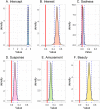Different routes to liking: how readers arrive at narrative evaluations
- PMID: 35907147
- PMCID: PMC9339064
- DOI: 10.1186/s41235-022-00419-0
Different routes to liking: how readers arrive at narrative evaluations
Abstract
When two people read the same story, they might both end up liking it very much. However, this does not necessarily mean that their reasons for liking it were identical. We therefore ask what factors contribute to "liking" a story, and-most importantly-how people vary in this respect. We found that readers like stories because they find them interesting, amusing, suspenseful and/or beautiful. However, the degree to which these components of appreciation were related to how much readers liked stories differed between individuals. Interestingly, the individual slopes of the relationships between many of the components and liking were (positively or negatively) correlated. This indicated, for instance, that individuals displaying a relatively strong relationship between interest and liking, generally display a relatively weak relationship between sadness and liking. The individual differences in the strengths of the relationships between the components and liking were not related to individual differences in expertize, a characteristic strongly associated with aesthetic appreciation of visual art. Our work illustrates that it is important to take into consideration the fact that individuals differ in how they arrive at their evaluation of literary stories, and that it is possible to quantify these differences in empirical experiments. Our work suggests that future research should be careful about "overfitting" theories of aesthetic appreciation to an "idealized reader," but rather take into consideration variations across individuals in the reason for liking a particular story.
Keywords: Appreciation; Bayesian multilevel modeling; Literature; Narratives; Reading.
© 2022. The Author(s).
Conflict of interest statement
The authors declare that they have no competing interests.
Figures



Similar articles
-
Predicting subjective ratings of affect and comprehensibility with text features: a reader response study of narrative poetry.Front Psychol. 2024 Oct 8;15:1431764. doi: 10.3389/fpsyg.2024.1431764. eCollection 2024. Front Psychol. 2024. PMID: 39439760 Free PMC article.
-
Reading about minds: The social-cognitive potential of narratives.Psychon Bull Rev. 2022 Oct;29(5):1703-1718. doi: 10.3758/s13423-022-02079-z. Epub 2022 Mar 22. Psychon Bull Rev. 2022. PMID: 35318585 Free PMC article. Review.
-
Thrilling News Revisited: The Role of Suspense for the Enjoyment of News Stories.Front Psychol. 2016 Dec 15;7:1913. doi: 10.3389/fpsyg.2016.01913. eCollection 2016. Front Psychol. 2016. PMID: 28018260 Free PMC article.
-
"Aha"ptics: Enjoying an Aesthetic Aha During Haptic Exploration.Perception. 2019 Jan;48(1):3-25. doi: 10.1177/0301006618818014. Epub 2018 Dec 19. Perception. 2019. PMID: 30567466
-
Greater art classification does not necessarily predict better liking: Evidence from graffiti and other visual arts.Psych J. 2022 Oct;11(5):656-659. doi: 10.1002/pchj.473. Epub 2021 Jul 19. Psych J. 2022. PMID: 34288523 Review.
Cited by
-
A comparison of art engagement in museums and through digital media.Sci Rep. 2025 Mar 15;15(1):8972. doi: 10.1038/s41598-025-93630-0. Sci Rep. 2025. PMID: 40089606 Free PMC article.
-
Predicting subjective ratings of affect and comprehensibility with text features: a reader response study of narrative poetry.Front Psychol. 2024 Oct 8;15:1431764. doi: 10.3389/fpsyg.2024.1431764. eCollection 2024. Front Psychol. 2024. PMID: 39439760 Free PMC article.
References
-
- Appel, R. (2003). De invaller. Retrieved from https://www.nrc.nl/%0Anieuws/2003/06/16/de-invaller-7642950-a1353672
-
- Bartsch A, Vorderer P, Mangold R, Viehoff R. Appraisal of emotions in media use: toward a process model of meta-emotion and emotion regulation. Media Psychology. 2008;11(1):7–27. doi: 10.1080/15213260701813447. - DOI
-
- Biesheuvel JMA. In de bovenkooi. Meulenhoff; 1972.
-
- Bürkner P-C. brms : An R package for bayesian multilevel models using stan. Journal of Statistical Software. 2017 doi: 10.18637/jss.v080.i01. - DOI
Publication types
MeSH terms
LinkOut - more resources
Full Text Sources
